Mento Judges Judgment
By Mento 4 Comments
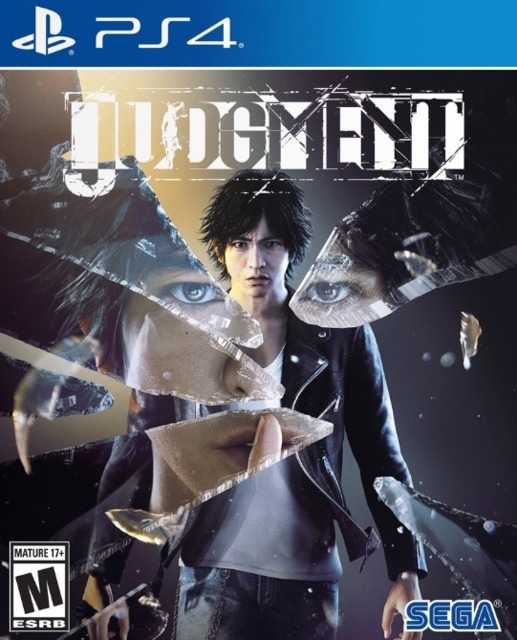
Hey there, all you Kamurochochachos, to another redundant edition of "Why the Yakuza games are good, actually." I've poked around this thorny and divisive issue a number of times previously, as I've been slowly catching up to Sega and Ryu ga Gotoku Studio's expansive open-world brawlers for the best part of a decade now: you can see previous efforts to delineate what makes these games so compelling from other city-based action-adventure games over here and here, for instance. My most recent playthrough? It's in the title, but here it is again: Judge Eyes (or I suppose Judgment if we gotta go with the lesser localized title).
My theme with the last one of these, regarding Yakuza 0, was to explore what was different. The new combat modes, Majima as the second protagonist, the new mini-games and features, and the way they integrated Japan's '80s economic bubble as a gameplay mechanic; I discussed how much I appreciated each of these changes on a case-by-case basis, while still acknowledging that any change, even one that was less enthralling than what was there before, is good for a series always at risk of being one walk around the red light district too many. I think the developers are keenly aware of that potential for monotony too, as Judgment exists as a sort of experiment in whether or not the Yakuza framework can be applied to a different kind of story and protagonist.
Of course, Yakuza games have had alternative protagonists before. In fact, Judgment's Takayuki Yagami reminds me a lot of Yakuza 4's Masayoshi Tanimura: a slippery law enforcement type who can comfortably work outside the legal system to chase down the really bad elements, conversing with Kamurocho's underworld figures for hints when necessary. However, Judgment feels significantly divorced from the usual Yakuza shenanigans with how every familiar aspect has been tweaked slightly to accommodate the new paradigm: Yagami fights with a couple of martial arts stances that again prioritize strength and speed respectively, but are based on Chinese kung fu rather than mostly self-taught streetfighting; a new (and unpleasant) serious injury mechanic makes it clear that Yagami is not quite as indestructible as his predecessors; some mini-games are more pronounced and others have vanished completely, to suggest that the new protagonist is an entirely different person with separate interests; and substories are now side-cases, which all follow the structure of taking on the job from a client, completing some detective-related tasks, intelligently using guesswork and abductive reasoning when needed, and - perhaps most importantly - getting paid by the client once the case has been satisfactorily closed.
As before with Yakuza 0, I'm going to go over each big shift and talk about how I feel they either improve the overall format or lessens it, with the above caveat that all change is ultimately to the benefit of a long-running series if it helps them keep improving and innovating. Hopefully this rundown will be of some use to those of you contemplating Judgment's upcoming enhanced release for PlayStation 5, Xbox Series S/X, or (I guess?) Stadia.
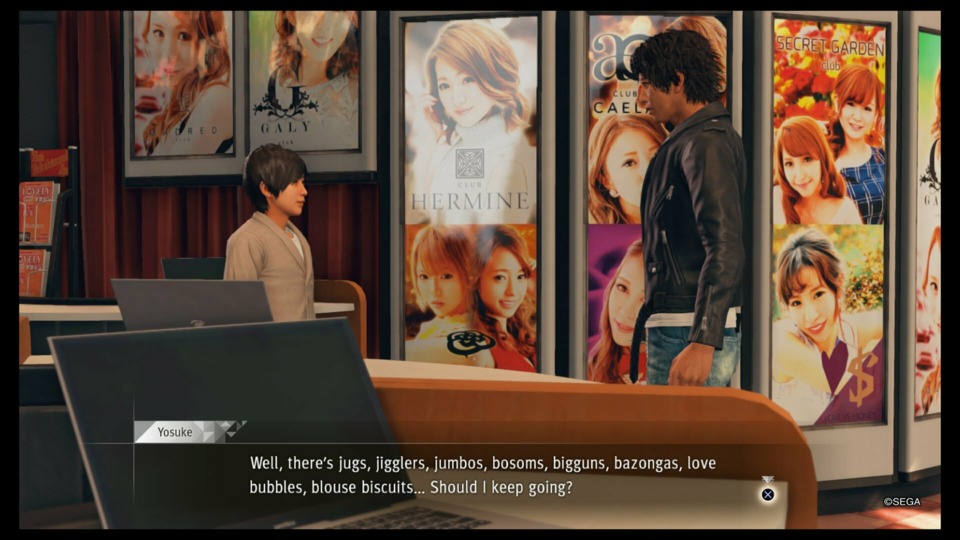
New Stuff
Fighting Styles
Yagami can fight with either Crane Style or Tiger Style kung fu: the former is presented as the best choice for crowds of weaker goons, while the latter is intended for one-on-one fights with heavies and bosses. What this initially boils down to is that Crane is flashier and faster, keeping you flipping around the place and out of reach of the stunlocking pile-ons that can often result when surrounded. However, Tiger eventually far outpaces it in terms of utility and damage alike due to how there are many Tiger Style-exclusive upgrades on the skill tree and no Crane Style exclusives. Still, there's a distinct benefit to quickly wrapping up a fight with a mob of randos with some rapid crowd control moves that remains valuable throughout the whole game.
Yagami's moveset also reflects his acrobatic prowess, with some Mirror's Edge moves such as wall jumps and leapfrog attacks that can keep opponents guessing and also work as defensive gambits when the need arises. If a heavyset goon with a larger health bar is running at you, you can just leap over his head, finish off the weaker adds behind him with Crane Style, switch to Tiger Style on the fly and then turn your attention to the now alone and easily outmaneuverable human bulldozer still momentarily verklempt by how you "mom's dead, parkour"'d over his considerable rear shelf. I always appreciate having more to do with the environments also, even if the wall jumping could be a mite finicky.
There is one constant between Yagami's Crane/Tiger styles and Kiryu's Komaki style: the Tiger Drop, which you have to learn from a QR code on a poster for some reason. Clearly a fan favorite if it was brought back in this contrived manner, the Tiger Drop is an incredibly powerful though incredibly precise counterattack: a risky move that requires you commit to attacking at the exact moment the enemy's blow is about to land, rather than dodging or blocking it to mitigate its damage. It is, bar none, the most satisfying move to pull off in any Yakuza game and its absence here would've been keenly felt.
Verdict: Net Positive. The new combat options bring some variety to what you can pull off while keeping things manageable with just the two modes to worry about, though they probably could've squeezed in more Crane Style upgrades as an incentive to use it more often.
Mortal Wounds
The Yakuza series has always had a hard time emphasizing just how rare and powerful a regular gun can be in Japan, even on the grimy streets of Tokyo's most dangerous district. Like most of the civilized world, Japan has outlawed handguns completely, and so if a gun ever pops up in a Yakuza game it's either some crappy old revolver handed down from a WW2 veteran grandparent, a police-issue piece that fell into the wrong hands (e.g. a policeman), or some international gun-running ring has somehow opened shop in one of the least gun-tolerated places in the eastern hemisphere and that's invariably treated as a huge deal. However, gameplay-wise all a gun has ever done is knock Kiryu on his ass and take off maybe 30% of his health bar, which is the type of minor setback that can be fixed with a quick conbini bento or a C.C. Lemon. Unless it happens in a cutscene, of course.
In Judgment, a bullet hurts. It hurts a lot. It hurts enough that the chunk of HP it takes off cannot be refilled - this is visually depicted as a red fractured health bar that is forever lost to you, surrounded by a chain link to indicate your new upper limit. Of course, mortal wounds aren't actually permanent, but they sure are inconvenient to fix: you either need a medical kit (which start at the low, low price of ¥40,000, or $400) or you can spend half that if you stop everything you're doing, run to the far northwest corner of the Kamurocho map, drop into the sewers, and pay the underworld doc to patch you up. Or you can just deal with having a shorter health bar for a while until it really becomes a problem.
I'm torn on this mechanic. On the one hand, the devs have finally successfully come up with a way of making guns the serious menace they ought to be. On the other, it's super annoying to deal with and isn't just limited to gunplay; every boss character goes into a heat action state (they all get a different color, which I appreciate; no reason everyone's burning soul should be orange tinted, after all) and while in that state they're able to pull off high-impact "finishers" which can also pile on this nigh-incurable damage. For story bosses it's more or less expected, but for random encounters with a certain mini-boss gang it can really put a damper on your day.
Verdict: Net Negative. I understand the purpose of its inclusion, but I'd prefer it stay a one-off or be a much rarer happenstance rather than something any old boss can smack you with.
P.S. I found the Tiger Drop button. #PS4sharehttps://t.co/PGtBrMPEha pic.twitter.com/zrhf8EdMOz
— Mento (@GBMento) April 7, 2021
Detective Side-Cases
Side-Cases operate much like Substories, with one notable difference being that many of them are locked until you've befriended a prerequisite number of Kamurocho citizens. The friendship idea was something floated in one of the earlier Yakuza games (maybe 3?) but comes to full fruition here, as you complete various minor objectives for tertiary characters to add them to your list of supporters. This could be as minor as buying a certain amount of goods from Poppo convenience stores and restaurants, to progressing in mini-games or performing some other task or challenge for them. You need all fifty to unlock the last two side-cases in the game, though the UI will helpfully point out any potential friends on the map.
The side-cases themselves require detective work, which usually involve a recurring set of mini-games I'll individually discuss below since they all play a major role in the story missions also. They fill the same function as the substories did in previous games: little narrative interludes, sometimes dramatic but usually silly and light, that are often the beating heart of any given Yakuza game. My favorites were probably Community Service Dracula, Human Fly Peeping Tom, and Blackmailed by Thirsty Boomers. It did feel like there were fewer ridiculous cases than usual though, sadly; the last Yakuza game was a more somber affair overall but still found time for goofy movie pastiches and punching great white sharks in the gullet.
Verdict: Break Even. The side-cases are still fun even with their new name, but they do tend to feel a bit repetitive given that being a detective apparently involves performing the same tasks over and over. However, the times where you get to be a smartypants Sherlock for the denouement make up for that. The friend requirement for unlocks is definitely some contrived extra busywork, but then completing some of those tasks can be entertaining too.
Tailing
I suppose it's natural that a lot of detective work involves following people around snapping surreptitious photos of their infidelity and other wrongdoings, but boy howdy do tailing missions suck in any game they appear in and the RGG Studio team were not the ones to crack the magical formula that could make them fun. What it always boils down to is very, very slowly following an overly-paranoid idiot as they make circuitous routes around Kamurocho to whatever love hotel or illicit gambling den they have their sights on, with you hiding behind various walls and cars to avoid detection. There's a few upgrades you can purchase to make this part of the game a little more tolerable, but my philosophy is that video game design shouldn't be about mitigating the parts of your game that are hot garbage and more about replacing those parts with something that works instead.
It wouldn't be so bad except tailing missions constitute about 40% of all mini-games required for story or side-case progression, and each one takes so long to get through and does nothing new besides having your tailee occasionally double-back for no other reason than to spite you and make the task take even more time. Every tailing objective is the longest, dullest game of Red Light, Green Light and I sighed every time I saw one coming after Yagami or another character made some comment about figuring out where some villain might be heading next. Just hack their phone's GPS instead; Judgment even bothers to introduce a tech savvy buddy of Yagami's who could do all that over the "Chatter" app but then sidelines him for most of the game.
Verdict: Net Negative. If there's ever a Judgment 2 I hope the staff devise more imaginative ways of tracking a suspect, or at least introduce way more mini-games to reduce their frequency.
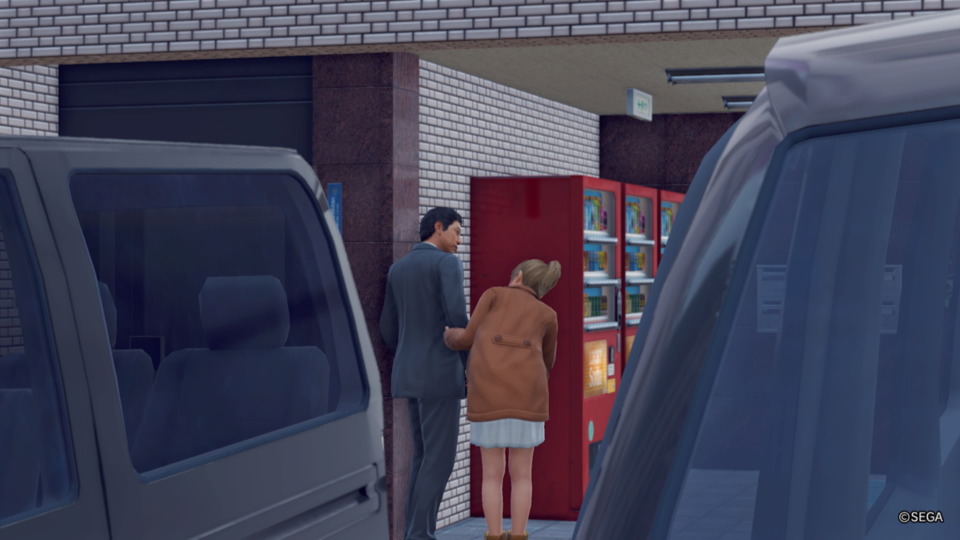
Lockpicking
The occasional B&E and trespassing is sometimes necessary to gain access to crime scenes and other valuable places of interest, and Yagami's a busy man with not a whole lot of friends on the force to lean on. As a result, he's become something of an accomplished lockpicker when the need arises. Oddly, lockpicking doesn't come up all too often in the side-content; it's mostly just a barrier when progressing through an enemy base, sometimes breaking up the series of battles.
There's actually two lockpicking mini-games: a good one and a bad one, and I always wished for the former. The good one involves raising a bunch of pins (or "shears") to the right points to make them "click" open, with some locks having more shears than others. The bad one involves turning the less-than-precise analog sticks to follow a glowing segment around a circle and repeating that process up to four times before the lock opens. As if to double-down on its awfulness, the second version also requires a finite resource of bent wires - though it'd be pretty hard to somehow burn through them all and they're like 100 yen each so you might as well fill up at the first opportunity and not worry about it.
Curiously, Yagami can also find keys to certain doors and must use the right one from his key ring to open them. You revisit many of these locked doors, including the one to your own office, and yet it's easy to forget which key goes where and just stand there like an idiot trying every one. I guess it was the developers' little idea of a joke: a touch of forgetful verisimilitude from what is otherwise a world-class detective.
Verdict: Net Positive. I wish there were more opportunities to lockpick doors, but I think that would probably budge the game's moral center from "it's fine, it's for a good cause" to "screw it, let's just burgle everywhere, no lock can stop me".
Drones
For the most part and divorced from the uncomfortable invasion of privacy concerns I think the inclusion of a spy drone is cool as hell, if only because it gives you a completely different perspective of Kamurocho: a city we've rarely been able to see from high up barring a few freerunning jaunts across rooftops. Once you've passed the particular moment in the story when it's introduced, the drone is something you can pop out at any time and go exploring the skies above Kamurocho, or more specifically about thirty feet off the ground before it starts threatening you with disconnections. It's naturally used in a few of the detective missions too, taking snapshots or spying through windows of tall buildings.
The other side to the drone business is preparing your off-the-shelf model with modifications to its motor, propellers, frame, ESC (Electric Speed Controller), and turbo, and racing it against other drones in a series of circuitous races through Kamurocho. The races are initially quite fun, but demand a certain level of precision later on when you're trying to navigate through doorways and up staircases for the more ridiculous tracks. The Champion's League grand prix, which requires conquering four other grands prix first, is one of the hardest racing-related challenges I've ever tackled, basically requiring you to hit all these narrow passageways without even slowing down if you want to remain in pole position. Fortunately, the drone controls are pretty responsive when it comes to mid-air course alterations and sudden turns, and the braking is near immediate; it reminded me quite a bit of the airplane races from Diddy Kong Racing, which is probably also the only reason I stuck with it. If you decide to get into drone racing, be forewarned that there's a huge amount of crafting and farming involved for the superior parts you'll need: it can get real expensive if you're looking for shortcuts, so I left most of that business until close to the end of the game.
Verdict: Net Positive. I did eventually manage to complete the Champion's League, somehow, but it was some harrowing stuff. The simple joys of just flying that thing around and colliding into people makes it a rad enough inclusion on its own.
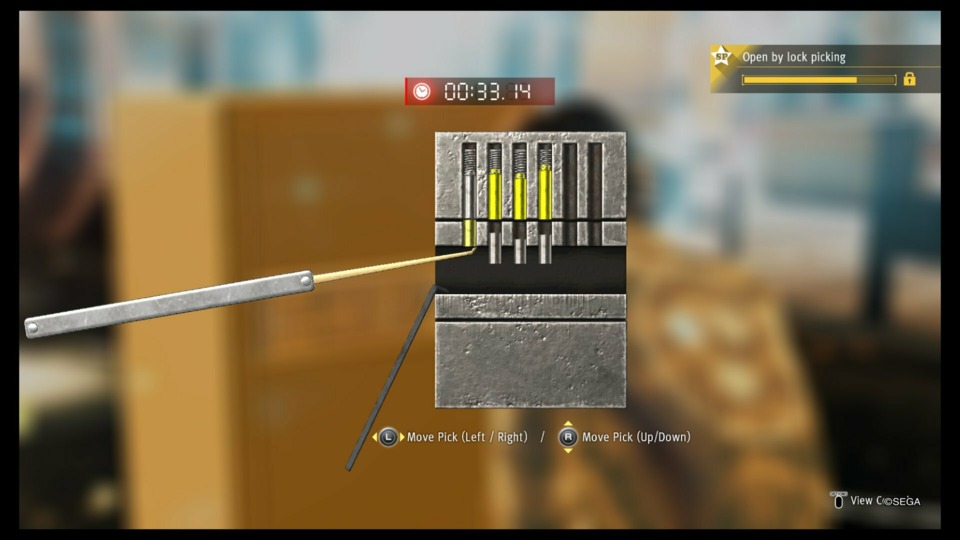
VR Paradise
I'll be brief here because I covered Judgment's Sugoroku-themed VR game-within-a-game over in this piece on Sugoroku as a whole (for the TL;DR crowd it's Chutes and Ladders with more complications). However, I will say that Judgment really lets its hair down in VR Paradise in terms of what it can do with the Dragon engine, since being a virtual reality allows it to get away with anything. That means if you wanted to fight Kiwami 2's tigers again, or wreck an entire convenience store with no repercussions, or fight a bunch of medieval samurai with a laser sword, VR Paradise has you covered on all fronts. You can also make a mint here: I managed to earn 7.5 million yen in a single session, which gave me quite the nest egg to rely on for the next few hours of mini-game tomfoolery.
The one downside is that the game is prohibitively expensive to play. The only means of playing early on is by finding "game pass" tickets, each course (short, medium, long) requiring a different amount. You can generally only find these passes after defeating enemies or completing other mini-games (the batting cages, for example, seemed to give them out a lot). Otherwise, you have to buy them from gambling dens for an equivalent of 100,000 yen each: not exactly feasible. One of the big game-wide challenges is finding six vouchers that together will make the game free to play forever, but they're not easy to get: three requires the equivalent of 1,000,000 yen in poker chips or hanafuda wooden tags each, and those are some of the easier ones to get. One actually requires beating the above Champion's League drone racing grand prix, which might not even be possible if you lack the skillset, while another involves taking on the hardest Homerun Derby course. It's basically infinite money once you have it unlocked though, so...
Verdict: Net Positive. I can understand why they gate it off, given how easily you can break the game with those payouts (Judgment also lets you buy experience with money, sort of, so you can imagine how badly that might go if you have full access early on), but it is a bummer that it's not something you can partake in easily because its VR-exclusive challenges are some of the most fun you can have with its engine. A little more stylistic craziness is always appreciated in Yakuza, from the narrative or elsewhere.
Kamuro of the Dead
Yakuza's always made a big deal of respecting Sega's history as an arcade developer, filling its "Club Sega"s with any number of classic arcade games from the former Super-Scaler Kings. Judgment has several recurring favorites itself - from Space Harrier and Fantasy Zone up to Fighting Vipers and Virtua Fighter 5 FS - with Puyo Puyo being both a highlight and the source of the hardest in-game checklist challenges to accomplish. Most Yakuza games also toss in a homespun arcade game of their own, like the shoot 'em up Boxcelios or Kiwami's MesuKing card fighter. Judgment's is a House of the Dead parody named Kamuro of the Dead, not too subtly riffing on the last Yakuza spin-off (to come out overseas at least): Yakuza: Dead Souls.
It's a very simplified version of The House of the Dead, moving you into little on-rails set-pieces against a number of zombie enemies which you have to shoot down before they can reach you. Headshots are the fastest way of putting zombies down, but the extra time lining up those shots could put you in peril. Boss fights involve shooting several target areas to deflect an attack, then applying some heat before they strike again. It's not particularly deep or layered, with only six stages that take about two or three minutes apiece. You also have the option to start over where you died, so it's not the most insurmountable challenge in the game. A fun idea though, and I hope someone on staff or a particularly motivated modder has the presence of mind to include a The Typing of the Dead variant when the port eventually hits PCs probably sometime next year.
Verdict: Net Positive. I'm all for more arcade games in Yakuza, bespoke or vintage, and I'm sure Sega appreciates this veneration of the company's coin-operated past. I think it'd be cool if another Dragon engine spin-off involved becoming King of the Arcades, with defeating many dozens of classic Sega games as the main impetus. Maybe they could talk to Square about a Hi Score Girl anime adaptation or something. It'd be a good use of whatever emulator tech those games use, at least.
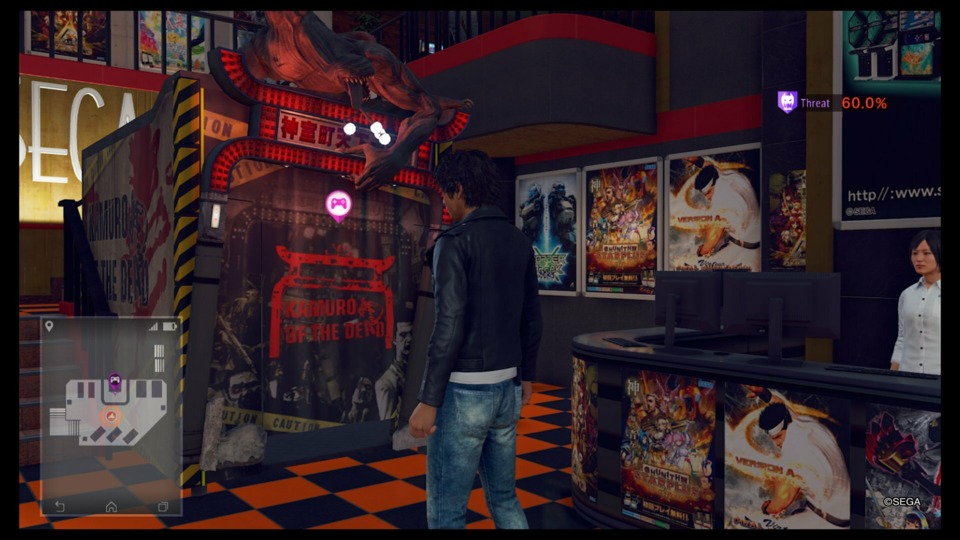
Quickstarter
The Yakuza games have always provided what I'd call a base level of verisimilitude upon which to build its more outlandish ideas, filling convenience stores and bars with actual products and trying to replicate the day-to-day life of habiting a bustling city landscape that never sleeps. Yagami will often navigate his busy life through his smartphone: there are "apps" that represent important menu considerations like inventories, case files and information, his skill tree, the drone, and other important functions. Late in the game, you get introduced to "Quickstarter": a crowd-funding platform that allows you to funnel your excess cash into unlocks of various utility. These projects might involve new skills for the skill tree, new consumables you can buy in stores, tools for mini-games (the "miracle" darts you can fund through Quickstarter renders that mini-game trivial), and even some competitive drone parts if you didn't want to mess around with building your own.
One of the oldest balance issues facing developers of RPGs was what to do about the economy. In RPGs, you either have barely enough GP or zenny or gil or what have you to buy the next set of armor and weapons for everyone, which forced exasperated players to waste time farming, or you've spent enough time on side-quests and optional dungeons that cash ceases to be an issue for the rest of the game. Yakuza's also had that "too much or too little" money issue, at least up until Yakuza 0 when cash became integral to character development and thus remained valuable throughout. With Quickstarter, you can simply flush all that excess cash away in short bursts or all at once to fund various projects - a neat feature is that other unseen crowdfunding donors will eventually fill each project's progress bar halfway, albeit after a very long amount of time - and never feel like you're wasting it.
Verdict: Net Positive. I was all ready to roll my eyes at this thing, from its close-but-not-quite-litigious name to what seemed like a naked attempt of trying to stay "with it" (which was always funny with Kiryu, who was perennially stuck in the past as a clueless oldie), but discovering that it was actually an ingenious solution to an age-old game design predicament made me appreciate its inclusion a whole lot more.
Pinball
I'm just tossing this in for Giant Bomb's newest (non-)employee Jeff Bakalar. Yes, Yagami has a pinball table in his office. No, you can't play it for the first few hours, so it just sits there taunting you like some immobile piece of furniture. Yes, it's unlockable eventually and, no, it's not particularly elaborate or entertaining enough to demand more than a few minutes of your attention.
For whatever reason, it's super easy to lose your ball on that table. It's probably why it gives you five balls to begin with and makes it easier to regain lost ones later. That made it a little irritating, but the in-game challenges related to the pinball were super easy to meet so maybe the developers weren't 100% satisfied with how it went either.
Verdict: Net Positive. I'm still going to give this a thumbs up anyway because the idea of a slightly wonky vintage pinball table taking up space in the already limited room in Yagami's hole-in-the-wall detective agency is so perfect a minor character embellishment that I don't even mind that it doesn't play so hot. Yagami's office is one of the most brilliantly designed locations in Yakuza history because it punctuates so well how much it kinda sucks: there's only room on top of the dusty wardrobe for any decorations, there's a record player despite no-one using record players except audio nerds who insist their sound is warmer, the kitchen sink is both tiny and constantly full of dirty dishes and takeaway packets, and if you want to get to the back of the room (where the pinball is) you have to squeeze past the couch every time. It's an amazing microcosm of Yagami's whole less-than-ideal situation.
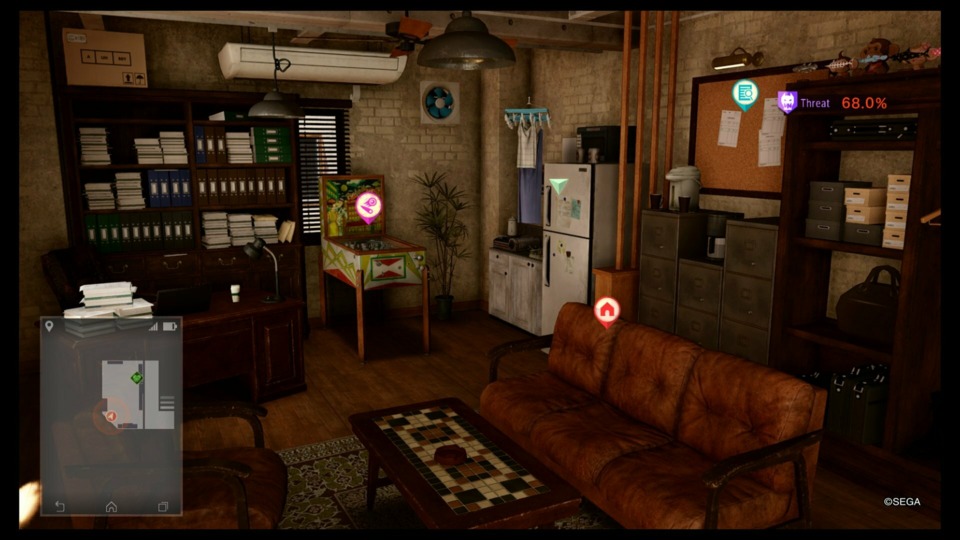
Bonus: The Amon Fight
You better believe there's an Amon fight. If you're not sure who this gentleman is I'll refer you back to this blog I made on each game's respective battle with this overpowered Matrix extra, but suffice it to say the Amon battle is something of a rite of passage for Yakuza fans who insist on doing everything, as he can usually only be reached after completing all the substories (or side-cases, where Judgment is concerned). He is, invariably, the toughest fight in any Yakuza game not just because he hits hard and has a health bar that is measured in feet rather than inches but because he will screw with you in ways you can never expect.
Because those unexpected trolls are the best part, I'll spoiler block the particulars below:
Anyway, I think I've talked enough about Judgment. I spend so long with each of these games that I always come away with a Dostoevsky novel's worth of material to write about, so forgive the loquaciousness. I'm a huge fan of these games, and while I think Judgment is a little bit on the weaker side overall there's easily enough going for it to merit a playthrough. There's some genuinely cool shit that happens and the story is brilliantly twisty. New console adopters and Stadia holdouts will have their chance to try it themselves later this week, so please give it a shot. (And if you want more than just my assurance, go read Alex Navarro's GOTY list for 2019 again. He makes an eloquent case for Judgment as his #1 pick.)
